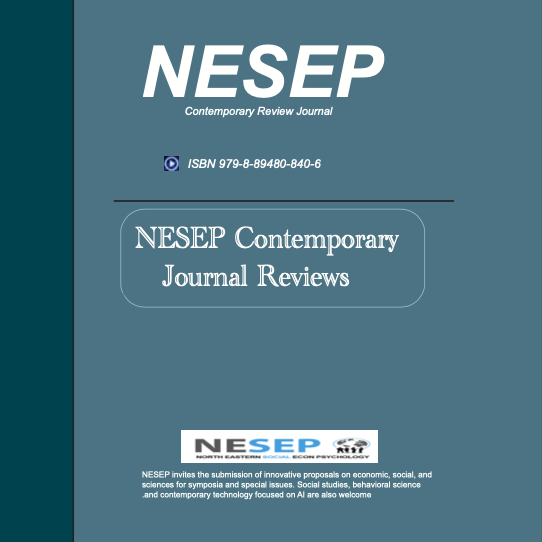Accepted Articles
We congratulate you on acceptance of your manuscript.

Annual Expo by the Journal of Young Explorers Meta and NESEP
- Fundamental or applied research
- Interdisciplinary research
- Judging on a rolling basis
- A work-in-progress research
- Completed research
- Unlimited topics and ideas
- ISBN 979-8-89480-840-6
- NESEP/NY-CSEF event at Harvard Club in NYC
The Role of Energy and Economic Growth for the Sustainable Environment
Abstract: Energy is essential for economic and societal development. Economic growth is closely tied to technological innovation, which can drive efficiency improvements and the development of cleaner technologies. However, economic growth often leads to increased resource consumption, which can exacerbate environmental issues. Sustainable economic growth involves decoupling economic development from resource consumption through resource efficiency and sustainable consumption patterns. Mitigating climate change requires transitioning to low-carbon energy sources, improving energy efficiency, and implementing adaptation measures to cope with its impacts. This research studied innovation in renewable energy for a sustainable society, leading to reduced environmental impacts and more sustainable growth. Since many developing countries still lack access to reliable energy sources, hindering their economic growth and quality of life, this paper also discusses how equitable access to energy is available to promote sustainable development. This study aims to achieve a sustainable environment that requires integrating energy and economic considerations into policymaking, encouraging innovation and technological advancement.
Keywords: Energy, economic growth, societal development, sustainable environment
References
-
Heal, G. (2009). Climate economics: A meta-review and some suggestions for future research. Review of Environmental Economics and Policy, 3(1), 4–21. DOI: 10.1093/reep/ren003
-
Jaffe, A. B., Newell, R. G., & Stavins, R. N. (2005). A tale of two market failures: Technology and environmental policy. Ecological Economics, 54(2-3), 164–174. DOI: 10.1016/j.ecolecon.2004.12.027
-
World Economic Forum. (2020). The Global Risks Report 2020. World Economic Forum. DOI: 10.23943/Princeton/9780691201009.001.0001
-
Dasgupta, P. (2001). Human Well-being and the Natural Environment. Oxford University Press.
-
Daly, H. E. (1996). Beyond Growth: The Economics of Sustainable Development. Beacon Press.
-
Barbier, E. B. (2007). Natural Resources and Economic Development. Cambridge University Press.
-
Goulder, L. H., & Schneider, S. H. (1999). Induced technological change and the attractiveness of CO2 emissions abatement. Resource and Energy Economics, 21(3-4), 211–253. DOI: 10.1016/S0928-7655(99)00009-3
-
Stern, D. I. (2004). The rise and fall of the environmental Kuznets curve. World Development, 32(8), 1419–1439. DOI: 10.1016/j.worlddev.2004.03.004
-
International Energy Agency. (2019). World Energy Outlook 2019. OECD/IEA. DOI: 10.1787/weo-2019-en
-
Acemoglu, D., Aghion, P., Bursztyn, L., & Hemous, D. (2012). The environment and directed technical change. American Economic Review, 102(1), 131–166. DOI: 10.1257/aer.102.1.131
-
Grossman, G. M., & Krueger, A. B. (1991). Environmental impacts of a North American free trade agreement. National Bureau of Economic Research. DOI: 10.3386/w3914
-
United Nations. (2015). Transforming our world: The 2030 Agenda for Sustainable Development. UN General Assembly. DOI: 10.1002/9781118391300
-
Neumayer, E. (2003). Weak versus strong sustainability: Exploring the limits of two opposing paradigms. Edward Elgar Publishing.
-
Piketty, T. (2014). Capital in the Twenty-First Century. Harvard University Press.
-
United Nations Development Programme. (2019). Human Development Report 2019: Beyond income, beyond averages, beyond today - Inequalities in human development in the 21st century. UNDP. DOI: 10.18356/78b829e1-en
-
World Bank. (2016). State and Trends of Carbon Pricing 2016. World Bank Group. DOI: 10.1596/978-1-4648-0758-6
-
Romer, P. M. (1990). Endogenous technological change. Journal of Political Economy, 98(5), S71–S102. DOI: 10.1086/261725
-
Nordhaus, W. D. (2007). A review of the Stern Review on the economics of climate change. Journal of Economic Literature, 45(3), 686–702. DOI: 10.1257/jel.45.3.686